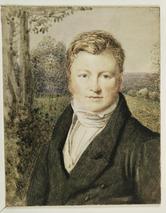day by day: a blog
July 21, 2009
family business
 [image: John Varley (1778-1842), by John Linnell] Sometimes, as cell by solitary, database cell I monotonously and relentlessly build up the genealogical reef that is the Family Ghosts website, I get the feeling, slightly Pynchonesque in a paranoid way, that every intellectual affiliation is subtended by an occult family connection.
[image: John Varley (1778-1842), by John Linnell] Sometimes, as cell by solitary, database cell I monotonously and relentlessly build up the genealogical reef that is the Family Ghosts website, I get the feeling, slightly Pynchonesque in a paranoid way, that every intellectual affiliation is subtended by an occult family connection.
Take W. B. Yeats’s well-known fascination at the end of the 19th century with the works of Blake and Shelley. Critics have usually parsed this passionate interest in the visionary strain of Romanticism either as being Yeats's way of disaffiliating himself from his father's mid-Victorian rationalism or as being symptomatic of the common Anglo-Irish obsession with the supernatural. Or, of course, as being both.
Yet it has apparently escaped notice that to the young Yeats Blake and Shelley must have been almost living, breathing presences, alive to him through a family tie. Yeats's mystically-inclined aunt, Isabella Pollexfen (1849-1938), who lived in London and gave her nephew a copy of A. P. Sinnett's Esoteric Buddhism in 1884, was married to the landscape artist John Varley (1850-1933).
Varley was the grandson of another well-known artist, also called John Varley (1778-1842). Both grandfather and grandson was fascinated by astrology and the occult, and the elder Varley was a close friend of William Blake. Varley and Blake shared a metaphysical fascination. Varley encouraged and took seriously Blake's visions. Indeed, between 1819 and 1825 during evenings at Varley's house in Great Titchfield Street, London, Varley and Blake collaborated on the 'Visionary Heads' project, producing together some 187 portraits of 'historical and imaginary figures' they saw in visions there. (For a detailed diagram of Yeats's relation to John Varley, click here.)
Yeats's uncle, the younger John Varley (1850-1933), was also the great-nephew of John Gisborne (d. 1835/36), who in 1800 married Maria Reveley (1770-1836), the friend of Godwin, Wollstonecraft and the Shelleys and to whom in July 1820 P. B. Shelley wrote the 'Letter to Maria Gisborne' while staying in the Gisbornes' house in Leghorn. In other words, Yeats's uncle was the great-nephew of Maria Gisborne. (For a detailed diagram of Yeats's relation to Maria Gisborne, click here.)
These faint, almost diaphanous but still suggestive, human connections stretching between Yeats and his iconic predecessors are not determinative. At least, I am certainly not willing to say they are. However, knowledge of them does add within the arid, abstract outlines of intellectual history a sense of subtle, emotional tincturing and warm plasticity, like a Romantically-shining watercolour wash added to a neoclassically-schematized, inked face.
When, in this familial context, Yeats studied the writings of Blake and Shelley perhaps it was almost -- subliminally or not, and in a way immediately reminiscent of the visitations from the beyond occurring at the séances which Yeats habitually attended during the period when he was also studying these artists – perhaps it was almost as if he heard their living voices murmuring to him from an adjoining room.
Through the younger John Varley, his uncle, the youthful W. B. Yeats might have seemed tantalizingly close to being 'in touch' with his chosen predecessors. Browning, in 'Memorabilia', supplied the essential poetic gloss on this eerie amalgam of nearness and farness which can sometimes be incarnated in an otherwise somewhat ordinary person:
Ah, did you once see Shelley plain,
And did he stop and speak to you?
And did you speak to him again?
How strange it seems, and new!
No-one, least of all me, can be immune to the frisson of that asymptotic approach to so much creativity and vitality, to that romance of feeling, for a while, only 'at one remove' from what we imagine to be the fully emancipated life.
Posted by njenkins at July 21, 2009 03:12 AM
With the exception of interspersed quotations, all writing is © 2007-09 by Nicholas Jenkins